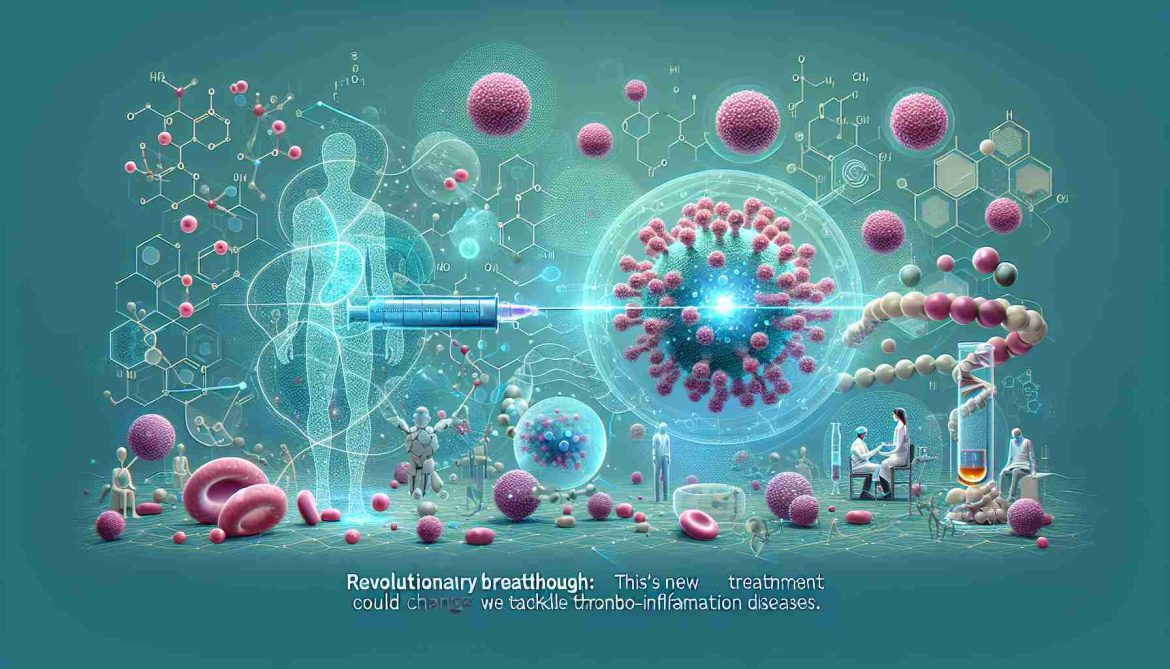- Aplagon is introducing APAC, a heparin proteoglycan mimetic aimed at treating thrombo-inflammatory diseases.
- The upcoming Phase 2a clinical trial will focus on peripheral arterial occlusive disease and chronic limb-threatening ischemia.
- Current trials include studies on arteriovenous fistula maturation failure and intravenous applications.
- CEO Aki Prihti emphasizes the unique targeting of treatment to vascular injury sites, broadening potential applications.
- Promising clinical results are expected by 2025 and 2026.
- Aplagon has secured investments from prominent firms, reinforcing confidence in their innovative approach.
Aplagon is on the brink of a medical revolution with APAC, a groundbreaking heparin proteoglycan mimetic. Targeting the very heart of arterial injuries, APAC promises to deliver formidable antithrombotic and anti-inflammatory effects. This innovative treatment is designed to address thrombo-inflammatory diseases that have long posed challenges to healthcare.
With new funding fueling their ambitious vision, Aplagon is set to kick off a Phase 2a clinical trial focusing on peripheral arterial occlusive disease (PAOD) and chronic limb-threatening ischemia (CLTI). They will also wrap up three existing trials: one examining arteriovenous fistula maturation failure, another involving intravenous applications in healthy participants, and a PET-imaging study utilizing cutting-edge zirconium-labeled technology.
Aki Prihti, the visionary CEO, expressed excitement about their distinct approach, which centers on targeting and retaining treatment at vascular injury sites. This technique opens doors not just for PAOD but for a wide array of severe vascular conditions, with promising clinical results anticipated in 2025 and 2026.
Investments from notable firms like Fåhraeus Startup and Growth AB (FSG) and the European Innovation Council (EIC) Fund, alongside Finnish backers, signify strong confidence in Aplagon’s mission. As they forge ahead, Aplagon’s work could illuminate pathways to treating a host of cardiovascular diseases, addressing a critical unmet medical need.
Stay tuned for what could be a game-changing advancement in vascular health!
The Future of Vascular Health: Aplagon’s APAC is Set to Transform Treatment Paradigms
Aplagon and the Revolutionary Promise of APAC
Aplagon is positioning itself at the forefront of vascular medicine with its innovative drug, APAC, a heparin proteoglycan mimetic targeting thrombo-inflammatory diseases. With a focus on arterial injuries, APAC highlights remarkable antithrombotic and anti-inflammatory properties. This new treatment approach springs from extensive research aimed at mitigating the challenges of managing complex vascular conditions.
Key Features of APAC
1. Targeted Mechanism: APAC is designed to effectively target and retain within vascular injury sites, potentially enhancing therapeutic outcomes.
2. Broad Application: Beyond peripheral arterial occlusive disease (PAOD) and chronic limb-threatening ischemia (CLTI), its implications in numerous cardiovascular diseases could revolutionize treatment methods.
3. Advanced Clinical Trials: Currently, Aplagon is conducting multiple clinical trials assessing various applications of APAC, including one for arteriovenous fistula maturation.
Innovations and Insights
Aplagon’s innovative use of zirconium-labeled technology in PET imaging sets a new standard for the visualization of drug behavior in vivo, aiding the understanding of treatment effectiveness. Moreover, the investment backing from Fåhraeus Startup and the European Innovation Council underscores the growing interest and confidence in new vascular therapeutics.
Market Trends and Predictions
The cardiovascular drug market is projected to grow significantly, driven by evolving healthcare needs and innovations like APAC. Experts forecast that if successfully developed, APAC may capture a substantial share of the market, especially as rates of vascular diseases continue to rise globally.
Pros and Cons of Aplagon’s APAC
Pros:
– Novel mechanism that targets specific vascular injuries.
– Potentially broader applications in treating multiple cardiovascular diseases.
– Supported by strong financial backing.
Cons:
– Currently in early-phase trials; long-term effects and efficacy are yet to be fully understood.
– Regulatory hurdles could delay market entry.
User Cases and Limitations
Use Cases:
– Management of chronic limb-threatening ischemia.
– Treating complications from diabetes-related vascular issues.
Limitations:
– Potential side effects need comprehensive evaluation through clinical trials.
– The understanding of its long-term impact on patient outcomes remains limited.
Related FAQs
Q1: What is APAC and how does it work?
APAC is a heparin proteoglycan mimetic developed by Aplagon, designed to treat thrombo-inflammatory diseases by targeting vascular injury sites, which enhances its therapeutic potential.
Q2: What diseases can APAC potentially treat?
APAC has potential applications in a variety of cardiovascular conditions, primarily focusing on PAOD and CLTI, but could also extend to managing complications related to arteriovenous fistulas and other severe vascular diseases.
Q3: When are we likely to see results from Aplagon’s clinical trials?
Promising clinical outcomes are anticipated in 2025 and 2026, as Aplagon progresses through its Phase 2a trial and finalizes its ongoing studies.
For further information about Aplagon and their groundbreaking work, visit aplagon.com.



